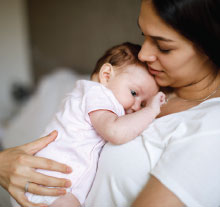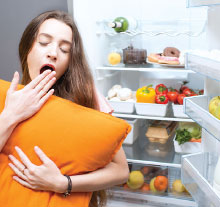Journal Digest: Home Environment; Postpartum Mental Illness; Placebo in Psychedelic Study; Single Gene Mutation; Topiramate
Nurturing Home Environment May Protect Against Depression

A study in the American Journal of Psychiatry has uncovered more evidence that raising children in high-quality rearing environments may reduce their future risk of depression.
Researchers from Virginia Commonwealth University School of Medicine and colleagues used linked data from multiple Swedish nationwide registries and health care data to compare depression outcomes in children who shared at least one parent with major depression and were raised either by their biological parents or adoptive parents.
The full sibling database included 666 adopted individuals who had 1,254 full siblings who were raised by the biological parent(s), and the half sibling database included 2,596 adopted individuals who had 5,511 half siblings who were raised by the biological parent. The researchers tracked the full and half siblings from age 15 to the time of first registration for major depression, death, emigration, or end of follow-up (December 31, 2015).
The researchers found that compared with home-reared full and half siblings, children who had been adopted had a 23% and 19% decreased risk of major depression, respectively.
“This protective rearing effect was not influenced by the relative educational status of the biological and adoptive parents. However, in both full and half sibships, the protective effect of adoption disappeared when an adoptive parent or stepsibling had major depression or the adoptive home was disrupted by parental death or divorce,” they wrote. “The rearing environment has a meaningful impact on risk for major depression, and this effect is likely mediated both by parental depression and the continuity or disruption of the home environment.”
Kendler KS, Ohlsson H, Sundquist J, Sundquist K. The Rearing Environment and Risk for Major Depression: A Swedish National High-Risk Home-Reared and Adopted-Away Co-Sibling Control Study. Am J Psychiatry. 2020;177(5):447-453.
Postpartum Mental Illness Reduces Odds of Future Births

Women who experience a psychiatric disorder after the birth of a first child are less likely to have more children, according to a study appearing in Human Reproduction.
Researchers at Aarhus University in Denmark and colleagues used Danish health registry data to assess the birth trends of 414,571 women who had their first child between 1997 and 2015. The women were followed until a second childbirth, death, emigration, age 45, or June 2016.
Of this group, 4,327 women were diagnosed with a postpartum psychiatric disorder (disorder was diagnosed six months or less after birth of first child), excluding intellectual disabilities or substance use disorders. The researchers calculated that about 69% of women with a postpartum diagnosis would have a second child within five years, compared with 82% of women with no diagnosis.
After adjusting for factors such as age, they calculated that a postpartum psychiatric diagnosis reduced the probability of a second birth by 33%. However, there was no difference in probability of a second birth between women with and without a postpartum psychiatric diagnosis if the child had died. The researchers noted this difference suggests the reduced birth rate in women with a postpartum diagnosis is in part voluntary.
When looking specifically at women whose disorder required hospitalization, the probability of a woman having a second childbirth was reduced by 47%, regardless of whether the child survived or not, “suggesting that the severity of maternal psychiatric disorders also directly or indirectly influences reproductive choices,” the researchers wrote.
Liu X, Plana-Ripoll O, Ingstrup KG, et al. Postpartum Psychiatric Disorders and Subsequent Live Birth: A Population-Based Cohort Study in Denmark. Hum Reprod. March 29, 2020 [Epub ahead of print]
Study Context Plays Role in Placebo Response in Psychedelic Study

Being told you are taking a psychedelic (even when given a placebo) may be enough to produce psychedelic-like side effects, reports a study appearing in Psychopharmacology.
“Understanding how context and expectations promote psychedelic-like effects, even without the drug, will help researchers to isolate drug effects and clinicians to maximize their therapeutic potential,” wrote the study authors from McGill University and colleagues.
The study involved 33 university students who believed they were enrolling in a study evaluating the effects of iprocin (a synthetic chemical that resembles psilocybin) on creativity. All participants ingested a single placebo pill, which they believed was iprocin, before spending time together in a setting that included music, lights, and visual projections for a four-hour period. The participants were periodically asked to complete verbal and visual creativity tests (such as completing a specified drawing in one minute). Before and after the four-hour period, all students completed the 5-Dimensional Altered States of Consciousness Rating Scale (5D-ASC), which measures 11 subjective experiences such as anxiety, insightfulness, and self-perception.
Overall, 61% of the participants reported at least one consciousness-related side effect, with some individuals reporting side effects typically associated with ingesting moderate-to-high amounts of a psychedelic.
“[U]nderstanding the psychedelic experience means isolating which parts are due to the drug itself and which are due to the contextual factors,” the authors wrote. “We hope that our results help shift the view of placebo effects from a necessary nuisance to a demonstration of the power of context in both modulating and creating the psychedelic experience.”
Olson JA, Suissa-Rocheleau L, Lifshitz M, et al. Tripping on Nothing: Placebo Psychedelics and Contextual Factors. Psychopharmacology (Berl). 2020;237(5):1371-1382.
Single Gene Mutation May Explain Why Autism Is More Common in Boys

Investigators at the National Institute of Neurological Disorders and Stroke have identified a genetic difference that might explain why autism spectrum disorder (ASD) is more common in boys than girls.
The variant is near a gene called Neuroligin 4 (NLGN4). This gene encodes proteins that help to establish and maintain synapses. NLGN4 is found on the X and Y chromosomes, and researchers had previously believed the NLGN4X and NLGN4Y proteins had similar functions.
Using biochemical and cell imaging analysis of neurons derived from human stem cells, the investigators found that despite these genes being 97% identical, a difference in one amino acid dramatically alters the expression of NLGN4X and NLGN4Y. The latter protein is not expressed on the neuron surface like NLGN4X, but inside the cell.
The male-derived neurons in which the NLGN4X gene was mutated had severe problems forming viable synapses because NLGN4Y could not compensate for the mutation. Female-derived neurons could function normally since they have two X chromosomes.
To support the importance of the NLGN4 gene, the investigators assessed the clinical literature and genetic disease databases and found several reports of children (mostly boys) with inherited forms of ASD or an intellectual disability who had mutations near the NLGN4X gene.
This study was published in Neuron.
Nguyen TA, Wu K, Pandey S et al. A Cluster of Autism-Associated Variants on X-linked NLGN4X Functionally Resemble NLGN4Y. Neuron. April 2, 2020. [Epub ahead of print]
Topiramate May Reduce Occurrence of Sleep Eating

The antiseizure drug topiramate can reduce nighttime eating binges and promote weight loss in people with sleep-related eating disorder, according to the results of a study in Sleep.
Like sleepwalking, sleep-related eating disorder is characterized by eating food while still partially asleep followed by little memory of the event. Several case reports have suggested topiramate, which is prescribed off label to treat binge-eating disorder, might be an effective treatment.
For this study, 34 adults who had experienced symptoms of sleep-related eating disorder for at least six months were randomly assigned to either daily topiramate (up to 300 mg) or placebo for 13 weeks.
At the end of the trial, participants taking topiramate reported a greater drop in the percentage of nights with eating per week (74.7% to 33.2%) compared with those taking placebo (77.0% to 57.4%). The participants taking topiramate also lost more weight after 13 weeks (8.5 pounds lost vs. 1.0 pound gained for placebo group).
Many of the participants taking topiramate experienced side effects, with skin tingling (paresthesia) and cognitive problems such as confusion being the most common.
According to the researchers, participants who had stronger memories of their nighttime eating were more likely to benefit from topiramate. ■
Winkelman JW, Wipper B, Purks J, et al. Topiramate Reduces Nocturnal Eating in Sleep-Related Eating Disorder. Sleep. March 30, 2020. [Epub ahead of print]



